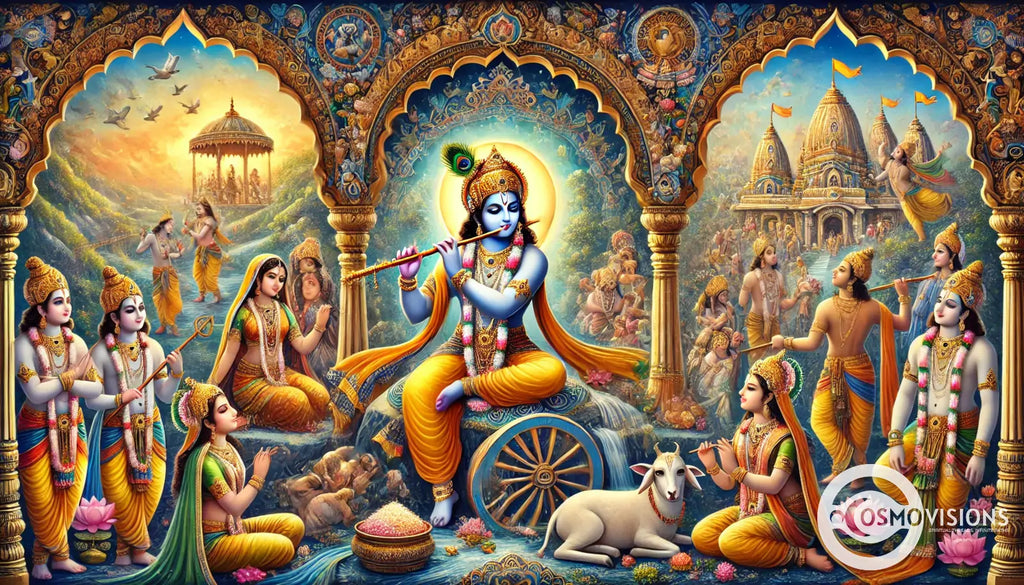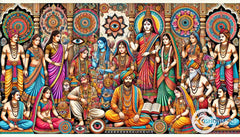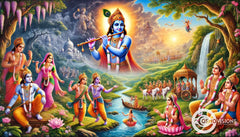Exciting Krishna Stories: Dive into the Stories of Lord Krishna
Posted by Massimiliano Geraci

Finding joy and wisdom in ancient stories might seem challenging for many, especially in a fast-paced world where old tales are often forgotten. Yet, the stories of Lord Krishna remain an exception, captivating hearts with their blend of divine playfulness and profound lessons.
Among the numerous deities in Hindu mythology, Lord Krishna stands out as a beacon of love, bravery, and wisdom.
One intriguing fact about these narratives is that they have been passed down through generations, not just within India but around the globe. This longevity speaks volumes about their universal appeal and the timeless virtues they encapsulate.
Our article aims to rekindle your connection with these enchanting tales by exploring both well-known episodes from Krishna’s childhood and lesser-known anecdotes that deepen our understanding of his life's impact.
Get ready to be inspired!
Who is Lord Krishna and Why Are His Stories Important?
Lord Krishna stands as a pivotal figure in Hinduism, symbolizing divine love and dharma. His life's narratives, from his miraculous birth to becoming a guiding force in the epic Mahabharata, encapsulate virtues that traverse beyond mere historical or religious confines.
These stories of Krishna offer profound insights into understanding righteousness, devotion, and the complexity of human emotions. Engaging with Krishna's tales enables individuals to explore the depths of moral dilemmas and ethical decision-making through allegories illustrated by his actions and teachings.
Krishna’s life—from battling demons like Putana in his infancy to delivering the sacred Bhagavad Gita's message on the battlefield of Kurukshetra—serves as spiritual canon and mirrors societal values and cultural heritage that continue to influence countless generations.
Each story is narrated for its mystical allure and as lessons on how virtue ultimately triumphs over vice. Through these narrative journeys, readers encounter a deity who is approachable yet enigmatic, whose exploits reveal universal truths about love, duty, courage, and sacrifice.
Krishna teaches us that true wisdom comes from embracing our duties with compassion and mindfulness.
Exploring famous childhood stories of Lord Krishna further showcases his mischievous nature blended with omnipotent capabilities—a combination attracting both young minds and adults alike towards timeless moral teachings.

Understanding the Life of Lord Krishna
Krishna's life begins in the fascinating tales of Hindu mythology, marked by his miraculous birth in a prison in Mathura. His parents, Devaki and Vasudeva, faced persecution from the tyrant Kamsa, who feared a prophecy that Krishna, the eighth incarnation of the supreme god Vishnu Narayana, would be his downfall.
To protect him, Vasudeva took Krishna across the Yamuna River to Gokul, where Nanda and Yashoda raised him. Krishna's youth as a cowherd in Vrindavan, or modern-day Gokula, was filled with divine play (leelas), showcasing extraordinary powers. He killed demons sent by Kamsa, lifted Govardhan Hill to save villagers from Indra’s wrath, and played enchanting tunes on his flute, captivating the hearts of gopis and devotees alike. His blue-black skin, often depicted wearing a yellow dhoti and a crown of peacock feathers, is a central image in art and devotion.
As he grew older, Krishna led the Yadavas to establish the kingdom of Dvaraka. His role transitioned to becoming a pivotal figure in epic narratives like the Mahabharata War at Kurukshetra, where he served as Arjuna's charioteer. Despite refusing to bear arms, Krishna's guidance in the Bhagavad Gita delivered profound wisdom on dharma (righteousness), a scripture that continues to guide millions.
Krishna's life also intersects with significant cultural practices and festivals. The holi explaining the festival celebrated with vibrant colors, is deeply associated with Krishna's youthful dalliances and divine love for Radha. Throughout his life, Krishna's relationships, whether friendships with Balarama and Sudama or his divine love with Radha, served greater cosmic purposes beyond mortal understanding, illustrating cosmic principles through human experience.
Krishna worship has profoundly shaped spirituality within Hinduism, influencing Indian culture, artistry, and philosophy. From Vrindavan paintings and dances inspired by Jayadeva's Gita Govinda to his image playing the flute surrounded by adoring devotees, Krishna's presence is ubiquitous. Vallabha discovered the central devotional figures associated with Krishna’s life, such as Govardhana, further enriching his legacy.
Krishna's story, including his youth, divine acts, and ultimate departure lamented by a huntsman in a forest, culminates in a legacy that transcends time. As a divine lover, protector, and supreme deity, Krishna embodies the essence of pure nondualism and remains a central figure in Hindu philosophy and worship.
The Significance of Krishna Stories in Hinduism
Krishna's birth stories hold a central place in Hinduism, serving not just as entertaining tales but as profound lessons in dharma (duty), bhakti (devotion), and karma (action). Through His life stories—whether it's playing with His friends in Vrindavan, lifting the Govardhan Hill to protect the villagers from Indra’s wrath, or imparting wisdom in the Bhagavad Gita—Lord Krishna exemplifies divine qualities.
These narratives convey moral values and virtues that guide followers in their daily lives. By embodying qualities such as love, courage, and wisdom, Krishna becomes a figure whose actions illuminate the path toward living a righteous life.
These accounts go beyond mere mythology to become essential teaching tools. Parents narrate stories of Krishna eating butter or showing the entire universe in His mouth to Yashoda to instill values like innocence, mischief blended with morality, and seeing divinity in every aspect of creation.
Such stories are not confined within temple walls; they resonate through festivals like Krishna Janmashtami and rituals across cultures within Hinduism. They engage individuals on multiple levels—intellectual, spiritual, emotional—making Sri Krishna an eternal source of inspiration regardless of one's age or stage of spiritual journey.
Moving forward into exploring "Why Krishna’s Life Stories Endure Through Generations" connects us directly with how these timeless tales adapt to changing societal norms while retaining their core messages.

Why Krishna’s Life Stories Endure Through Generations
Tales of Lord Krishna capture hearts across generations because they resonate with themes like devotion, virtue, and the triumph over evil. These stories are narrated in every household, striking a chord with both children and adults alike.
They blend the mystical allure of lord krishna's divine persona with human emotions, making them accessible and relatable. His life’s episodes, from his miraculous birth to defeating demons like Keshi and charming the poison out of the Yamuna river with his celestial, poetry music and painting, showcase his godly powers wrapped in captivating storytelling.
His role as a guide during the Kurukshetra War highlights his wisdom and dharma teachings through the sacred text Bhagavad Gita. This narrative solidifies Krishna's place in spiritual consciousness and exemplifies moral guidance that transcends time.
The enduring popularity of these tales underscores their impact on shaping ethical values and spirituality among followers around the globe.
Krishna's stories illuminate paths for humanity to follow virtues amidst adversities.
What Are Some Famous Childhood Stories of Lord Krishna?
The stories of Lord Krishna's childhood resonate deeply within the spiritual and cultural fabric of Hinduism. These narratives, filled with divine playfulness and profound wisdom, remain etched in the hearts of those who cherish Indian spirituality and art. Here is a list of some celebrated tales from Krishna’s early years, each a testament to his divine nature and earthly adventures.
1. Krishna's encounter with the Demoness Putana beautifully illustrates the theme of innocence overcoming malevolence. Disguised as a wet nurse, Putana came to poison Krishna. Yet, with divine insight, child Krishna sucked the life out of her instead, liberating her soul.
2. The tale where Krishna lifted Govardhan Hill to protect the villagers from Indra's wrath showcases his power and compassion. Defying Indra, the god of rain and storms, Krishna sheltered his people under the mountain like an umbrella, teaching everyone about faith and protection.
3. Yashoda witnessing the universe in Krishna's mouth opens minds to the infinite nature of Lord Krishna. Upon seeing mud in his mouth, Yashoda demanded he open wide, only to behold galaxies swirling inside him, revealing his omnipresence.
4. The playful saga involving Krishna stealing butter signifies his mischievous yet beloved character among Vrindavan’s residents. Stealthily entering homes, Krishna loved sharing the stolen butter with monkeys; this act endeared him further to everyone except those whose butters were pilfered.
5. Narratives describing how young Krishna dealt with Kaliya portray his role as protector even at a tender age. By dancing on the serpent Kaliya's heads in Yamuna River and eventually sparing its life after defeating it showed both his might and mercy.
6. Singing tales that involve horse demons like Keshi sent by evil king Kamsa to kill Krishna reveal heroism intertwined with destiny. Despite such formidable foes' attempts at ending his life prematurely, they met their end by Krishna’s hands instead; thus fulfilling a prophecy protecting Dharma.
7. The enchanting acts of young Gopala calling forth cattle with his flute encapsulate pastoral harmony and divine allure in one frame. His music not only tamed wild beasts but also drew hearts closer to spiritual awakening.
Through these narratives filled with miraculous deeds and endearing antics reside lessons on virtue, devotion, courage among many others that continue guiding generations towards a path enriched by faith and righteousness.
Krishna’s Encounter with the Demoness Putana
Krishna demonstrated divine prowess early in his life, most notably during his encounter with the demoness Putana. Sent by the evil King Kamsa to eliminate Krishna, Putana took the form of a beautiful woman and visited Yashoda's home, where baby Krishna was living.
She carried poison intended for Krishna, disguising it within her breast milk. Unaware of her malicious intent, Yashoda allowed Putana to nurse Krishna.
Miraculously, young Krishna sucked not just the poisoned milk but also drew out Putana's life force. The demoness transformed back into her giant form as she succumbed to the power of supreme god, Lord Krishna.
Villagers came running at the sound of kamsa hearing a prophecy of her monstrous wails only to find that despite being targeted by such malice, baby Krishna remained unscathed and smiling. This event is celebrated in tales across Hinduism and portrays an early glimpse of Krishna’s divinity and protection against evil forces sent by Kamsa that sought to harm him since he was born—the eighth child prophesied to bring about the downfall of tyrannical reigns like Kamsa's.
The Tale of Krishna and His Friends in Vrindavan
In the lush groves of Vrindavan, Lord Krishna and his friends set out on adventures that remain etched in the corridors of spirituality and art. The banks of the Yamuna bore witness to their childhood escapades, from herding cattle to krishna playing mischievous pranks on the villagers, encapsulating a divine blend of innocence and divinity.
These stories serve not just as bedtime tales but as profound lessons in friendship, loyalty, and joy.
Famed episodes like Krishna taming the venom-spilling serpent Kaliya or lifting Govardhan Hill with just his little finger reveal his godly powers within human-like endeavors. Through these acts, Lord Krishna taught the villagers—and through stories passed down generations, us—the values of courage, respect for nature, and protection of community over self-interests.
As devotees danced uninhibited by worries during these celestial interventions by young Krishna at Vrindavan's core, they underscored an untouched spiritual camaraderie shared between a deity and his followers—a theme celebrated across cultures fascinated by Hindu mythology.

Yashoda’s Experience When Krishna Opened His Mouth
Yashoda's experience with Krishna unveils a profound moment of divine revelation, one that transcends the ordinary bounds of motherly affection and delves into the cosmic mysteries.
Krishna, who was often found mischief-making, presented an inexplicable scenario to his mother Yashoda by swallowing mud. Concerned for her son's health and guided by maternal instinct, Yashoda asked him to open his mouth.
Upon compliance, rather than finding the anticipated dirt, she gazed upon the universe itself within the dark cavern of Krishna’s mouth. This moment encapsulates not just the boundless nature of Krishna but also signifies a pivotal realization for Yashoda about her child's divine essence.
Krishna saw the entire cosmos in His mouth.
This narrative is rich with symbolism that speaks volumes about Krishna's role as an avatar and bridges the earthly experiences to celestial truths. It serves as a unique testament to Lord Krishna’s omnipresence and omniscience while reinforcing Yashoda’s significance in nurturing divinity incarnate amidst humanity.
The tale further cements Krishna's identity within Hinduism as not merely a mischievous child but as encompassing all creation within himself, affirming his stature among deities capable of revealing universal truths through simple yet profound acts witnessed by those around him.
Can You Share Some Lesser Known Stories of Krishna?
Exploring the life of Lord Krishna reveals a tapestry rich with divine play and profound wisdom. Among his many tales, some lesser-known stories stand out, offering unique insights into his character and the cultural heritage of Hinduism. Here are several captivating episodes from Krishna’s life that echo the depth of his teachings and antics:
1. The Encounter with Keshi: This demon, sent by King Kamsa to eliminate Krishna, took the form of a massive horse. Demonstrating divine power, Krishna bravely confronted Keshi, ultimately grabbing him by the legs and swirling him in the air before throwing him down, which led to the demon's demise.
2. Krishna Saves His Village from a Deluge: When Indra, the hindu god of rain and thunderstorms, became infuriated with the villagers for not performing sacrifices to him but instead following Krishna's advice to worship Mount Govardhan for their sustenance, he decided to submerge Vrindavan under torrential rains. Krishna lifted Mount Govardhan on his little finger like an umbrella protecting his devotees and animals from Indra's wrath for seven days until Indra realized Krishna’s divinity and apologized.
3. Subduing the Serpent Kaliya: The Yamuna river was poisoned by the serpent Kaliya, endangering its inhabitants. Undeterred by the perilous waters or the fierce snake guarding them, Krishna danced on Kaliya’s heads after a vigorous battle, eventually sparing its life on the condition it would leave the river, thus restoring purity and safety to its waters.
4. Krishna’s Mischievous Acts in Vrindavan: Known for his love for butter, Krishna would often steal freshly churned butter from neighboring houses with his friends. These playful acts led to delightful encounters with village women who complained to Yashoda about her son’s thievery - only to be charmed by Krishna's innocence.
5. Dancing on The Head of Kaliya: After defeating Kaliya in a show of divine might, Lord Krishna performed a dance on its head that captivated both foes and allies alike. This event celebrates his triumph over darkness and toxicity.
6. Reviving Sage Sandipani’s Son: As gratitude towards his guru Sandipani Muni for educational tutelage without any expectation of return (Guru Dakshina), Krishna set out on a journey deep into cosmic areas alongside Balarama (his brother) to bring back Sandipani Muni's long-lost son from death as requested by their teacher.
Each krishna story depicts various facets of courage, devotion, mercy, and wisdom embedded within Lord Krishna's myriad leelas (divine play), continuing to inspire spirituality followers around the globe.
The Encounter with the Serpent Kaliya
Lord Krishna, in his youth, faced the ten-headed serpent Kaliya who was poisoning the water of the Yamuna River. The villagers were terrified as their livelihood depended on this river's clarity.
Displaying courage and a sense of duty beyond his years, Krishna took it upon himself to confront Kaliya. He found the enormous serpent in the depths of the river and engaged in a fierce battle that mesmerized those watching from the banks.
"Krishna's father danced atop Kaliya's heads with such divine skill that eventually, worn out and defeated, Kaliya acknowledged Krishna's superiority. This act wasn't just about subduing a dangerous creature; it symbolized purification—a turning point where poison left space for purity to flourish again in Yamuna’s waters.
By dancing on its heads, Krishna forced out all poisons from Kaliyā into its own body, sparing everyone around them from harm and teaching an invaluable lesson about overcoming toxic forces with grace and strength.
How Krishna Defended the Village from Indra’s Wraith
Transitioning from Krishna's encounter with the Serpent Kaliya, another tale unfolds showcasing his divine powers. This time, it was against Indra's wrath. The villagers of Vrindavan, led by Nanda, decided to worship Govardhan Hill instead of performing their traditional sacrifices to appease Indra.
Angered by this slight, Indra decided to unleash torrential rains upon the village in an attempt to demonstrate his supremacy and teach the villagers a lesson.
Krishna, understanding the peril that loomed over Vrindavan due to Indra’s decision, took it upon himself to protect his kin and kith. In an unprecedented display of divinity, he lifted Govardhan Hill with just one finger.
Underneath this massive shelter, the entire village found refuge from Indra's relentless downpour for seven days and nights. Despite his fierce temper and formidable power as a deity controlling rains and storms amidst their cries for help came Krishna; he ensured they were safe and untouched by hunger or despair during this time under tragic threats which could have obliterated them into oblivion had it not been for Krishna’s timely intervention.
Amidst stormy vengeance and celestial fury stood Krishna—unwavering—a beacon of hope shielding Vrindavan against indomitable forces.
Krishna’s Divine Flute and the Gopis
Krishna played his divine flute, and the melodies that flowed from it possessed a magical quality unlike any other. Each note seemed to carry the weight of emotions, reaching out to the hearts of the Gopis in Vrindavan.
Enchanted by these tunes, they left whatever tasks they were engaged in, drawn irresistibly to Krishna. The power of Krishna's alone playing the flute surrounded and did more than just produce music; it created an unbreakable bond between him and the Gopis, highlighting his role as a central figure in their lives and within the broader tapestry of spirituality.
The gatherings around Krishna as he played showcased a unique form of devotion, where love overflowed and boundaries dissolved. These moments stand out as pivotal episodes that offer insights into the depth of Krishna for children stories.
They illustrate how spiritual love transcends conventional norms, leading to a state where divinity intertwines with human affection. As narrated through Lord Krishna stories for kids and embraced by devotees across generations, these tales encapsulate lessons on devotion and the beauty of selfless love—the kind that sees beyond worldly limitations and connects souls at a transcendental level.
How Did Krishna Become a Hero in the Mahabharata Epic?
In the tapestry of the Mahabharata epic, Krishna emerges as a pivotal hero, not through might alone but through wisdom and guidance. Acting as Arjuna's charioteer in the battle of Kurukshetra, he delivered the Bhagavad Gita's profound teachings on dharma (duty), steering Arjuna away from his moral dilemma with words that still resonate today.
This discourse between deity and mortal transcends a mere battlefield conversation; it unfolds layers of philosophical insights, establishing Krishna as a central figure who expertly addresses challenges with divine insight.
Krishna's intervention didn't stop at verbal guidance; his strategic prowess was instrumental in numerous instances throughout the conflict. Notably, he devised plans that led to the downfall of key adversaries like Duryodhana and Kamsa, altering the course of events with minimal force yet maximal impact.
Through these actions—coupled with miracles such as revealing his divine form—he solidified his status beyond that of a mere warrior or deity. Krishna became synonymous with compassion, strategy, and righteousness embodied within human history and cosmic lore alike, capturing hearts long past the era depicted in ancient texts.
Krishna's Role in the Battle of Kurukshetra
Vasudeva Krishna played a pivotal role in the Mahabharata, particularly during the Battle of Kurukshetra, where he served as Arjuna's charioteer. His guidance and wisdom were crucial in leading the Pandavas to victory.
Despite being a powerful hindu deity, Krishna chose not to wield weapons or directly participate in combat. Instead, he offered strategic counsel that proved instrumental in overcoming adversaries like Jarasandha and Kamsa.
Whenever dharma declines and the purpose of life is forgotten, I manifest myself on earth. - Krishna
He delivered the Bhagavad Gita's teachings to Arjuna amidst the battlefield's chaos, providing insights into duty (dharma), righteousness, devotion, and spirituality. The Gita’s discourse has since been a cornerstone of Hindu philosophy and ethics.
Krishna’s actions during this epic war underscore his commitment to upholding righteousness over might, influencing countless generations with lessons of courage, selflessness, and moral clarity.
The Guidance Given to Arjuna by Krishna
In the midst of the epic battle of Kurukshetra, Arjuna found himself in a moral dilemma, paralyzed by the thought of fighting against his own kin. It was at this critical juncture that Lord Krishna, serving as his charioteer, imparted wisdom that would transcend time.
Through a profound dialogue that became known as the Bhagavad Gita, Krishna revealed to Arjuna deeper insights into dharma (duty), righteousness, and the impermanence of life. Emphasizing action without attachment to results, Krishna guided Arjuna to understand his duty as a warrior was not just toward his family but toward upholding justice and righteousness for society's greater good.
Krishna’s teachings did not simply pertain to warfare or familial ties; they offered an encompassing philosophical foundation for living one's life with purpose and detachment from material gains.
By urging Arjuna to act according to his dharma without expecting rewards for actions performed, he introduced a transformative way of engaging with the world—one rooted in selflessness and duty-bound honor.
These lessons from Krishna during such a pivotal moment highlight how sacred texts like the Bhagavad Gita continue to inspire readers towards ethical decision-making and spiritual enlightenment today.
Moving forward from these eternal teachings shared on the battlefield leads us directly into exploring "The Teachings of Dharma by Lord Krishna".
The Teachings of Dharma by Lord Krishna
Lord Krishna's exposition on Dharma, as detailed in the Mahabharata epic, serves as a pivotal cornerstone for understanding the essence of duty and righteousness. Through His divine discourse to Arjuna on the battlefield of Kurukshetra, Krishna elucidates the concepts of action without attachment, the importance of fulfilling one's responsibilities, philosophical system of pure will and the pursuit of righteous living.
His guidance transcends mere moral instruction; it encapsulates a universal philosophy that harmonizes individual agency with cosmic order.
Krishna declares that every individual has a specific role or 'svadharma' suited to their position in life and their inherent nature. By adhering to this dharma through selfless service ('karma yoga'), devotion ('bhakti yoga'), and contemplative knowledge ('jnana yoga'), one contributes to the maintenance of cosmic balance while attaining personal spiritual growth.
A.C. Bhaktivedanta Swami Prabhupada extensively writes about these teachings, emphasizing their relevance not just within Hinduism but across all walks of life seeking enlightenment and fulfillment beyond material gains.

What Lessons Can Children Learn from Krishna Stories?
Krishna stories enchant children with tales of divine feats, but they also impart crucial lessons on morality and virtue. Through engaging narratives about Krishna defending the village from Indra’s wrath or his playful yet profound interactions with his devotees like Yashoda and Narada, children grasp the importance of humility, compassion, and devotion.
These stories showcase how even a god widely revered in Hinduism values respect for all life forms and demonstrates the power of true friendship and love. By hearing about Krishna's boundless kindness and bravery in facing demons like Keshi or protecting innocents from harm, kids learn that strength lies not just in physical might but in the goodness of one's actions.
Moreover, narratives such as Krishna waking up to dance happily to tunes or showing undying affection towards his sister Devaki highlight familial bonds' sanctity. Children discover through these captivating bedtime stories that loyalty to loved ones and courage to stand up for what is right are virtues as powerful as any magic.
Engaging youth with these ancient tales encourages a deep-rooted sense of duty towards family and society while nurturing an appreciation for cultural heritage rooted deeply within texts revered by followers of Durga, Narada, Brihaspati, among others.
This unique combination of adventure, spirituality, and moral teaching makes Krishna stories popular among parents wanting their kids to learn timeless values amidst fun-filled storytelling sessions.
Moral Values and Virtues from Krishna’s Life
Throughout his life, Lord Krishna exemplified a multitude of moral virtues that continue to inspire and guide individuals across the globe. Compassion stands at the forefront of these values, as seen through numerous tales where Krishna intervened to protect both his devotees and the innocent.
His interaction with the serpent Kaliya showcases not only his strength but also his mercy in sparing the serpent’s life on condition it would no longer harm others. This story along with others serves as a powerful lesson on practicing kindness even in situations demanding sternness.
Krishna's wisdom transcended age, offering profound guidance during times of turmoil. The famous counsel given to Arjuna amid the battle of Kurukshetra emphasizes dharma (righteous duty) above personal grievances or fears, urging leaders and followers alike to uphold truth and justice regardless of personal cost.
Such teachings from Krishna instill a sense of duty towards righteousness and highlight the importance of wisdom in overcoming life's challenges. Through engaging narratives like these, stories from Krishna’s life impart lasting lessons on virtue, making them cherished not just among children but across all ages interested in spirituality, anthropology, and Indian arts.
Why Krishna Stories Are Popular as Bedtime Stories
Krishna stories hold a special place in the tapestry of bedtime tales, resonating with both children and adults alike. These narratives weave together moral values, spiritual insights, and captivating adventures that transport listeners to ancient times where divine play unfolds.
The tales of Krishna fighting demons like Keshi or protecting his devotees from rain illuminate the virtues of courage, faith, and love. Parents see in these stories an opportunity to instill deep-rooted ethical principles in their children.
Reading about Krishna's mischiefs with friends in Vrindavan or how Yashoda discovered the universe in his mouth offers more than just entertainment; they offer lessons on humility, devotion, and curiosity.
Each night, as tales of Krishna lifting Govardhan Hill to save villagers from Indra's wrath are told, imaginations soar and bonds strengthen. Fathers recounting these episodes become heroes themselves, embodying the protective love Krishna showed for his own followers.
Through engaging storytelling moments—be it by book light under blankets or by a dim lampshade—a connection forms not just between parent and child but between generations past and future who have passed down these timeless stories.
Such moments affirm why Lord Krishna's narratives remain beloved bedtimes stories across ages: they teach life’s profound truths through simple yet powerful anecdotes that touch hearts deeply rooted in spirituality and familial love.
How to Narrate Krishna Stories for Kids
Crafting captivating tales about Lord Krishna for kids calls for an engaging narrative style that brings the mystical adventures of this divine figure to life. Start by setting a vivid scene that transports young listeners to the ancient lands of Vrindavan and Mathura, where Krishna's exploits unfolded.
Highlight key episodes like Krishna defending villagers from the wrathful Indra or his playful encounters with demons such as Keshi, ensuring to weave in moral and ethical lessons subtly without undermining the entertainment quotient.
Utilize direct speech from characters like Yashoda, Nanda, and sage Narada to make stories more dynamic and relatable. Inject humor through anecdotes of Krishna stealing butter or outwitting his friends in Vrindavan, making sure these moments resonate with contemporary sensibilities while retaining their cultural essence.
Emphasize values such as bravery, compassion, and wisdom that children can learn from Krishna’s actions and decisions throughout his journey. Engage your audience by using expressive gestures or different voices for characters to keep youngsters enthralled and eager for more tales of divine playfulness and heroism.
Moving on, let's explore who were the prominent devotees and companions that played significant roles in Krishna's life story.
Who Were the Prominent Devotees and Companions of Krishna?
Lord Krishna's life brims with tales of devotion, showcasing the deep connections he formed with a cast of diverse figures. These individuals, stemming from varied corners of mythological narratives and historical epochs, played pivotal roles in illustrating the multifaceted nature of devotion itself.
1. The tale of Radha and Krishna transcends mere stories to embody the zenith of spiritual love and devotion. Radha, often considered an avatar of Goddess Durga, represents the soul's intense longing for a divine union with the supreme consciousness that Krishna embodies. Their love story is celebrated widely in various art forms, becoming a symbol of pure love.
2. Yashoda left an indelible mark on Krishna's childhood narratives as his foster mother. Her unconditional love for Krishna – despite his mischievous deeds that ranged from stealing butter to releasing all the cows in Vrindavan – teaches lessons on maternal affection and patience. Stories like when Yashoda ran after Krishna to punish him for stealing butter only to be spellbound by the vision of the universe in his mouth are etched in devotees' hearts.
3. Nanda, head of Vrindavan and Krishna's foster father, provides a strong example of paternal love and leadership. His role showcases how nurturing guidance fosters growth in extraordinary ways, guiding Krishna from infancy into his youthful years as he took on demons like Putana and Keshi.
4. Narada Muni acts not just as a devotee but also plays a crucial role as a celestial sage who bridges divine messages across different planes. His connection with Lord Krishna is vital as it spans across many pivotal episodes including warning Kamsa about his eventual downfall at Krishna’s hands.
5. Rohini (wife of Vasudeva) offers insights into resilience and hope amidst adversity. Despite being imprisoned alongside her husband by Kamsa, she kept faith alive which eventually saw their son Krishna becoming a beacon of hope for many.
6. Draupadi’s relationship with Lord Krishna showcases loyalty and respect transcending ordinary friendship ties – highlighted during her trial by disrobing where Krishna miraculously prevents her dishonor by providing endless cloth to protect her dignity.
7. A.C Bhaktivedanta Swami Prabhupada prominently spread Lord Krishna’s teachings globally through setting up ISKCON (International Society for Krishna Consciousness). His life’s work made knowledge about Lord Krishna accessible beyond Indian borders while emphasizing bhakti or devotional service towards God.
These companions and devotees illuminate diverse facets of spirituality, revealing how devotion can take multiple forms yet lead to the singular truth embodied by Lord Krishna’s teachings.
The Love Story of Radha and Krishna
The love story of Radha and Krishna transcends the mere concept of romance, representing a divine manifestation of human love, that continues to inspire millions. This tale is deeply rooted in Hindu mythology and embodies the essence of spiritual devotion.
Radha, often depicted alongside Krishna, symbolizes the soul’s intense longing and devotion for the Divine. Their relationship serves as an exemplar of unconditional love and has been celebrated through various art forms across generations.
Krishna's playful interactions with Radha on the banks of Yamuna, their dance together during moments untainted by worldly concerns, convey profound truths about spiritual unity and eternal love.
Their stories are not just tales from a time long past but serve as moral compasses for devotees around the world. The narrative underscores that true devotion transcends physical boundaries, leading one along a path of spiritual enlightenment.
Through depictions in literature, paintings, and songs, the saga of Radha and Krishna captures hearts by illustrating how divine love can elevate souls beyond earthly limits.
Who Was Narada and His Connection to Krishna?
Narada, a divine sage and one of the most intriguing figures in Hindu mythology, played a pivotal role as a messenger between gods and humans. Known for his ability to travel through different realms at will, Narada became instrumental in shaping the cosmic play or Leela that Krishna orchestrated on Earth.
His devotion to Lord Vishnu—of whom Krishna is an avatar—led him to become one of Krishna's ardent devotees. Through celestial songs and hymns, Narada extolled Krishna's virtues, spreading his divine love and messages across the cosmos.
Krishna cherished Narada's companionship for it was through him that many tales of devotion and Dharma were conveyed. One significant story involves Narada warning Kamsa about Krishna's eventual role in his downfall, which set into motion the events leading to Krishna's epic battles against demons like Keshi.
Furthermore, Narad’s interactions with residents of Nanda’s village exemplify how he bridged the human-divine divide by narrating stories of unparalleled feats performed by Krishna—from lifting Govardhan Hill to protect villagers from rain to vanquishing demons—that entertained and imparted spiritual wisdom.
Yashoda and Krishna: The Heartwarming Bond
Yashoda's bond with Krishna illuminates the depths of maternal love, transcending biological ties. From the moment Krishna was born to sister Devaki and her husband, Yashoda took Krishna into her care, embodying an unconditional love that saw beyond the divine origins of her adopted son.
Her days filled with caring for Krishna, from leaving him to sleep peacefully to addressing his mischiefs with a blend of concern and adoration. This connection highlights the human ability to nurture divinity and marks a profound chapter in Hinduism where Yashoda became his devotee through sheer love.
Krishna's childhood in Nanda’s village under Yashoda’s watchful eyes is replete with tales that blend earthly joys and celestial wonders. Complaints about Krishna stealing butter or showing the universe in his mouth were met with astonishment by Yashoda, yet they never dimmed her affection.
These incidents weave together a narrative where divine acts are mingled seamlessly with everyday life, making Yashoda's household an epicenter for stories where villagers were dancing happily around them—unfazed by miracles but touched by the warmth of familial bonds.




























